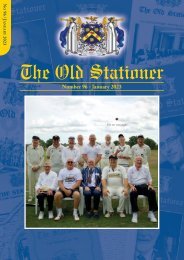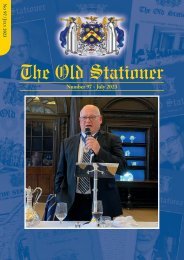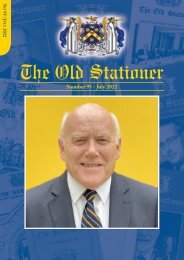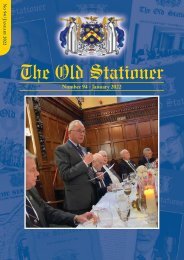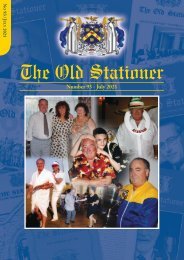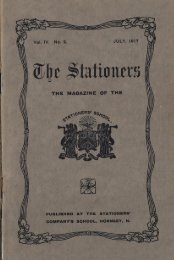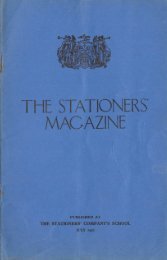OSAmag88
Create successful ePaper yourself
Turn your PDF publications into a flip-book with our unique Google optimized e-Paper software.
T h e O l d S t a t i o n e r - N o 8 8
THE FIRST OF THE FALLEN
Samuel Billing and Evan Hare were the first of 154 Old Boys
from Stationers’ School to be killed in the First World War. They
are both briefly mentioned in Robert Baynes’ book, ‘A History of
Stationers’ Company’s School’. Their story, like many, tells the tale
of a happy Edwardian life spent in Hornsey during the early part
of the 20th Century only to be abruptly interrupted by the turmoil
and carnage of war. I wanted to discover their stories and
backgrounds, their family lives and sad tragic endings. I could only
achieve this by extensive research into their families, schooling and
careers to fully realise their experiences and the paths they took in
life, coming from different backgrounds. Through their stories I
would discover the happy and comfortable childhoods they led,
with love and support from their families, through to adulthood
when their worlds were turned upside down in the chaos and
horror on the battlefields of France, culminating in their untimely
deaths, to become part of the ‘Lost Generation’.
Samuel Billing
Samuel Alfred Billing was born in King’s Cross on the 16th
February 1896 at 101 Gray’s Inn Road, WC1 to George and
Ellen Billing, he was to be the fourth of seven children. Their
father worked for the Metropolitan Borough of St Pancras but as
their family grew in size George soon realised that they needed
to move into larger accommodation. At that time, new homes
were being built in the fields around the village of Hornsey on
land acquired by the British Land Company to accommodate
overcrowding in Central London, offering clean air and spacious
living. With the building of Hornsey Station on the Great
Northern Line, commuting was to be the new attraction to
affordable suburban living. George applied for a new job at
Harringay Borough Council as a Meat Inspector and the family
put their name down for a house in Frobisher Road on the
recently built Hornsey Station Estate, later known as the
‘Harringay Ladder’. They moved into number 67 in early 1901
and a new Primary school was soon to be built in the same road,
just a few yards from their home. Samuel was enrolled at North
Harringay Council School in late Summer of 1902 where he
remained until 1907. It soon became apparent that Samuel was a
Peter Thomas lays a wreath at the grave of Samuel Billing
Poppy wreath laid on behalf of Old Stationers'
bright young boy of exceptional ability and plans were therefore
made to move him up into suitable higher education once he had
completed his final term at North Harringay. The recent building
of Stationers’ Company’s School within the local vicinity seemed
the ideal opportunity to further Samuel’s education, however it
was clear that his family would struggle to afford the school fees
of 62 shillings per term. A scholarship was therefore sought to
fund his education and the school Governors at the Stationers’
Company were approached by Hornsey School Board to seek
financial assistance. On recognising the potential of Samuel’s
abilities, the Governors awarded him a Thomas Brown
Scholarship (Thomas Brown was a wealthy Book Binder with
premises in Bishopsgate, on his death in 1869 he had bequeathed
to the Company the sum of £5,000 for apprenticeships in book
binding and a further £5,000 to create a scholarship for the
School). Once his scholarship had been secured, Samuel joined
the School in 1907 where he remained until passing his final
exams in the Summer of 1913. Whilst at the School the family
would move again into a larger house, in 1911. George, Ellen and
their family moved to 22 Ribblesdale Road on the other side of
Hornsey Station. On leaving school, Samuel remained at the
family home and trained as an accountant working for the local
firm of Barrow Fish who were accountants to the Treasury
Department at Hornsey Council in Hornsey Lane. It was whilst
he worked here that war broke out in 1914 and not long after
Samuel decided to join the British Expeditionary Force(BEF) to
fight in France.
Between the beginning of August and early September 1914,
Samuel reported for enlistment at the Territorial Army Offices
in Priory Road, Hornsey enrolling in the Queen’s Westminster
Rifles, later to become part of the 16th Battalion, London Rifles.
He joined at the same time as the Headmaster of the School,
John Huck, who before the
war served as a part-time
Territorial Army Officer
whilst teaching at the School.
Shortly after joining Samuel
received orders to report to the
Regiment’s headquarters at 58
Buckingham Gate,
Westminster for basic training
consisting of physical fitness,
military knowledge and drill.
On completion of his initial
training he was sent to
Leverstock Green Farm near
The Thomas Brown Scholarship
medal similar to the medal presented
to Sam Billing during his studies at
the school.
20



